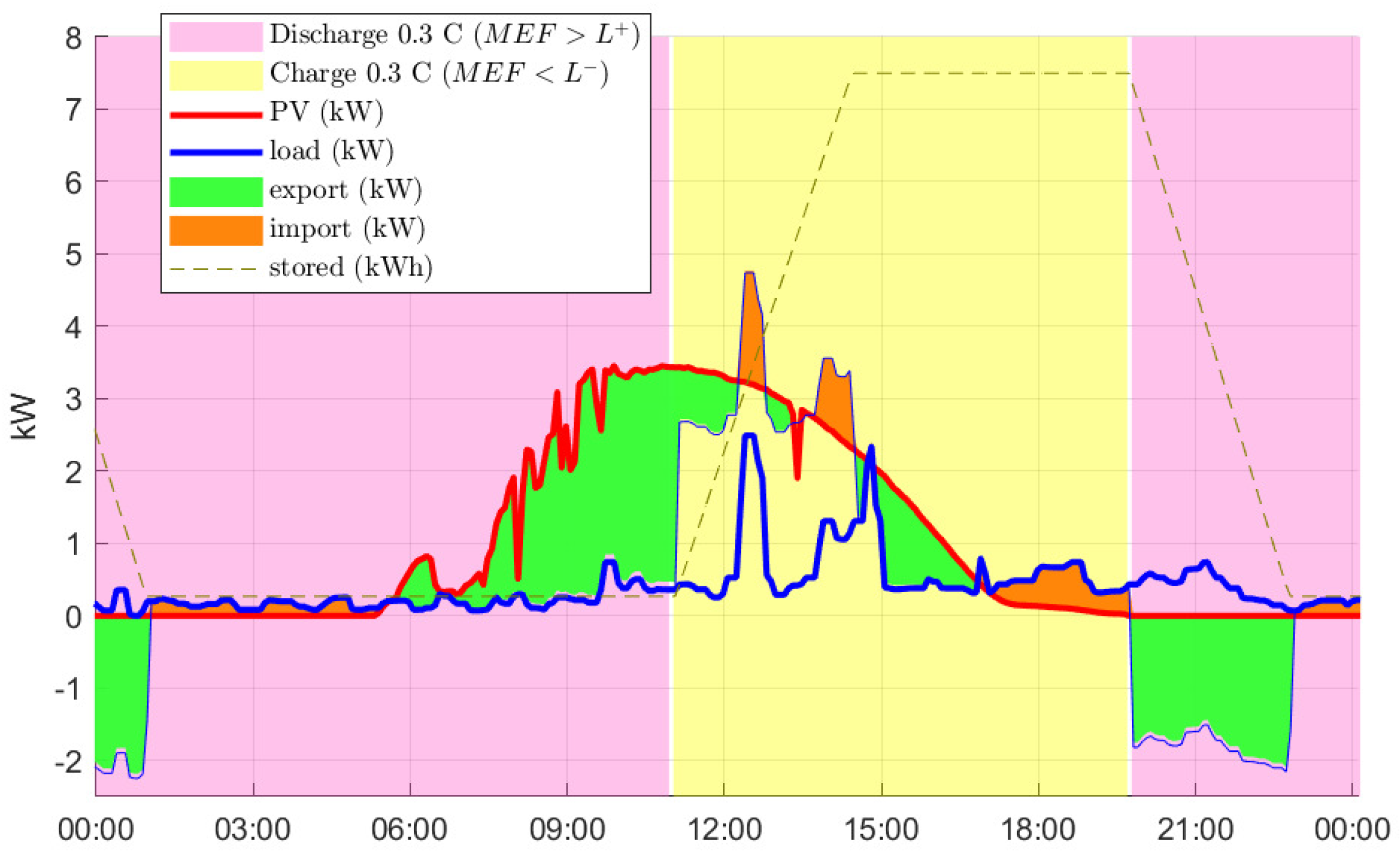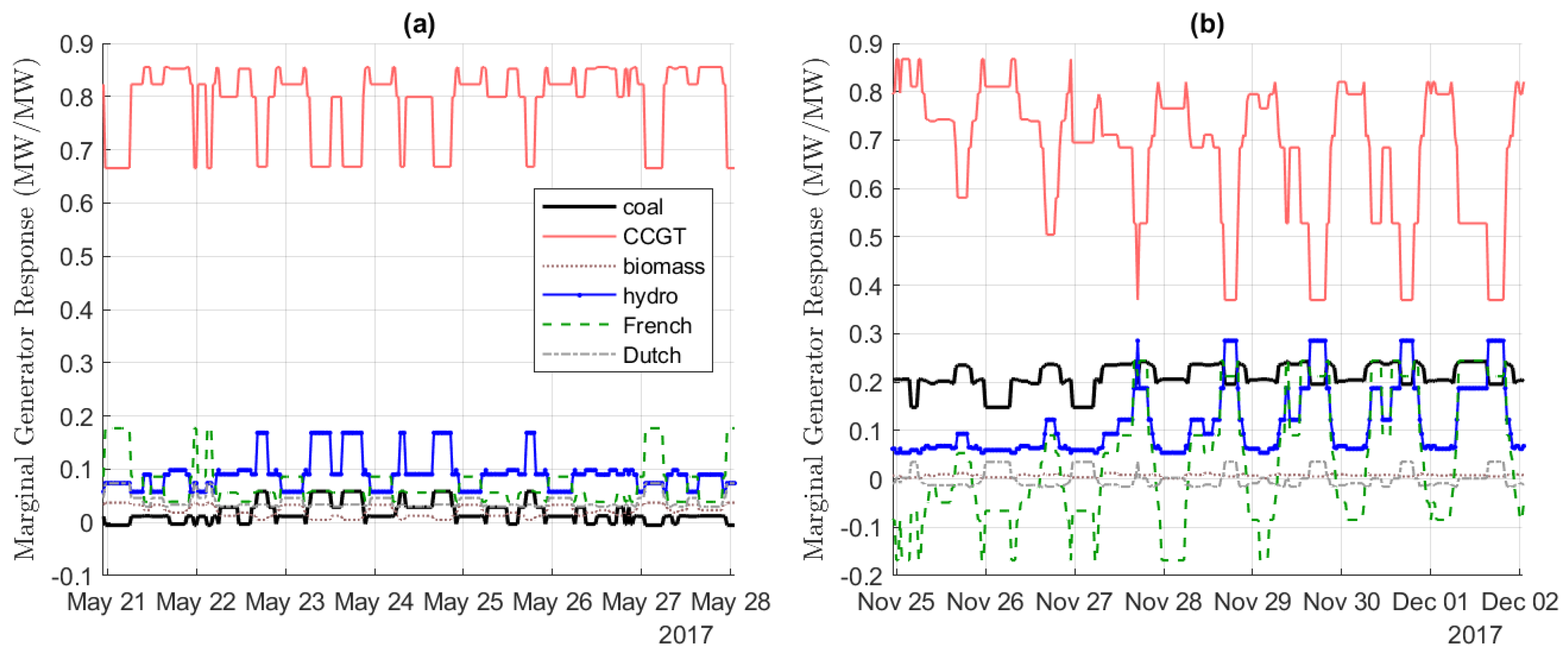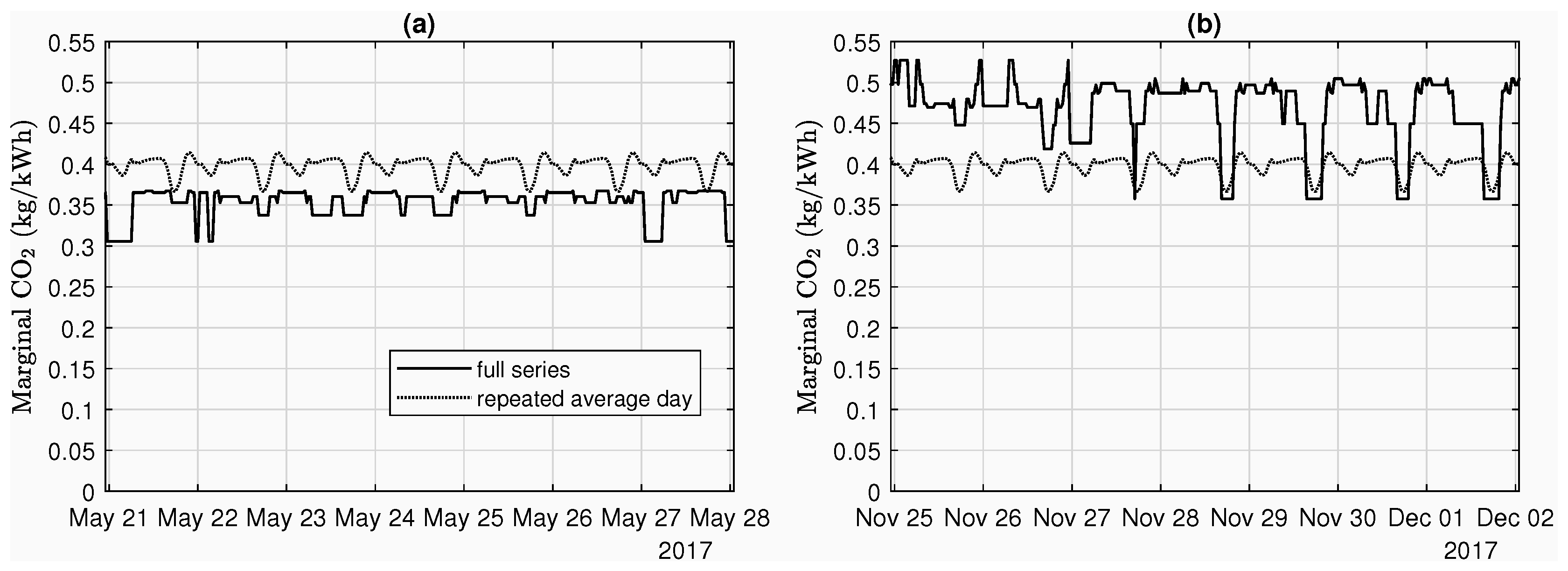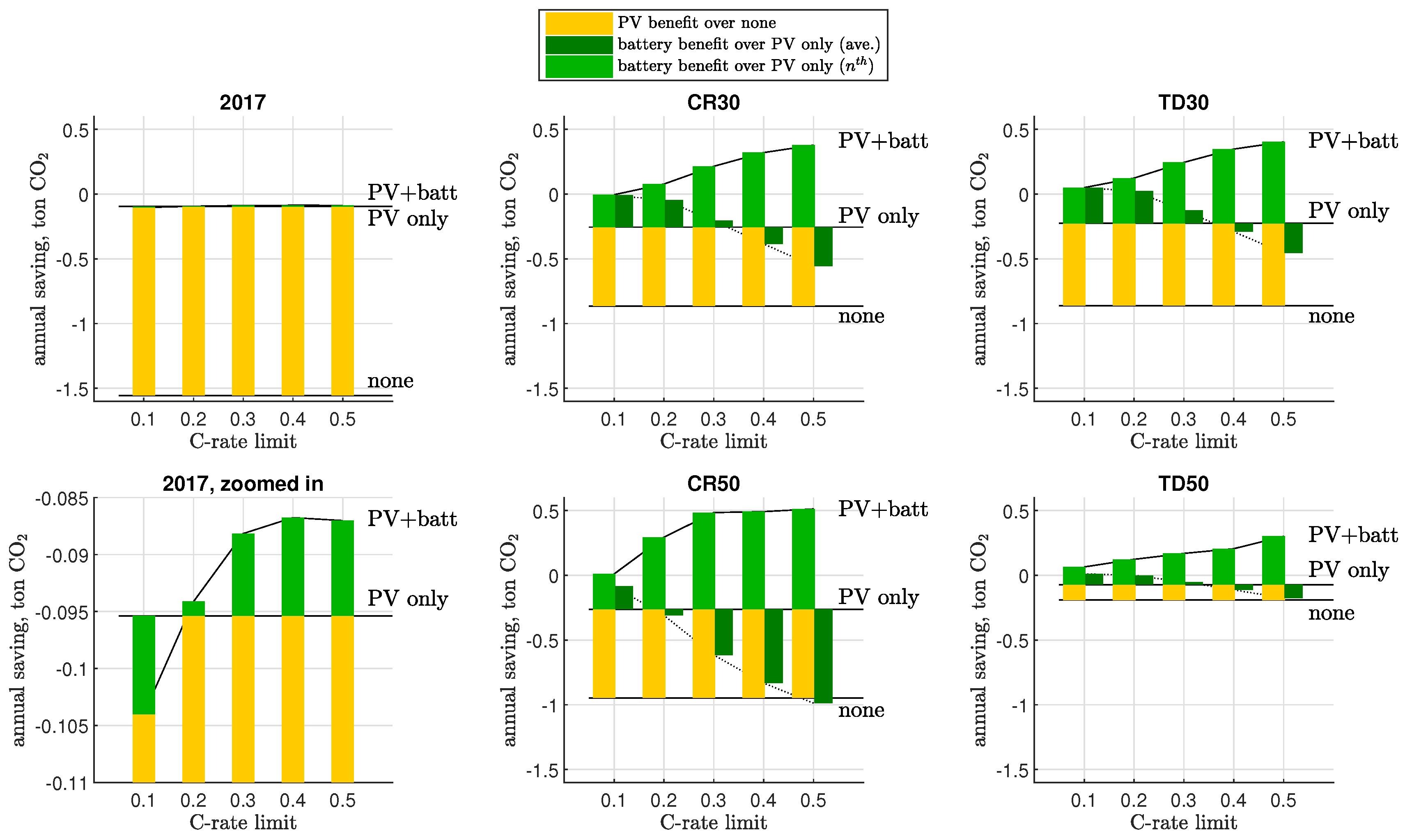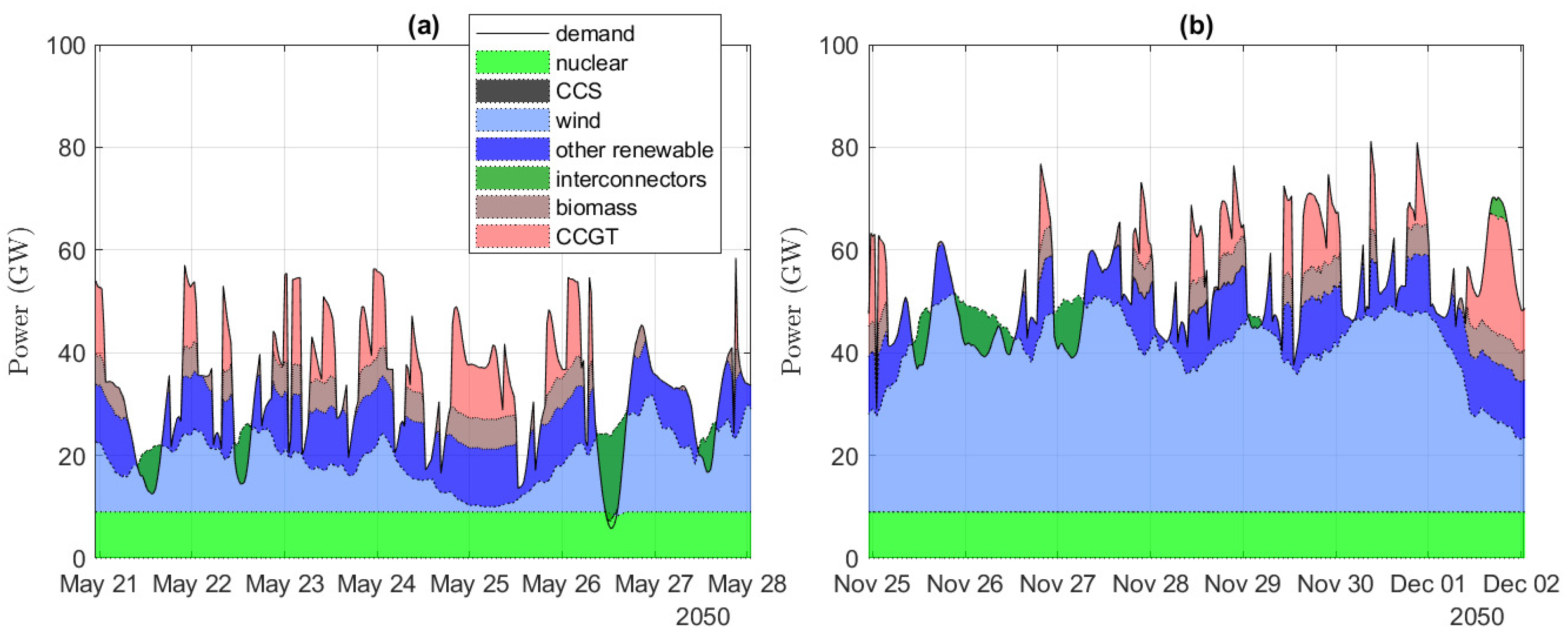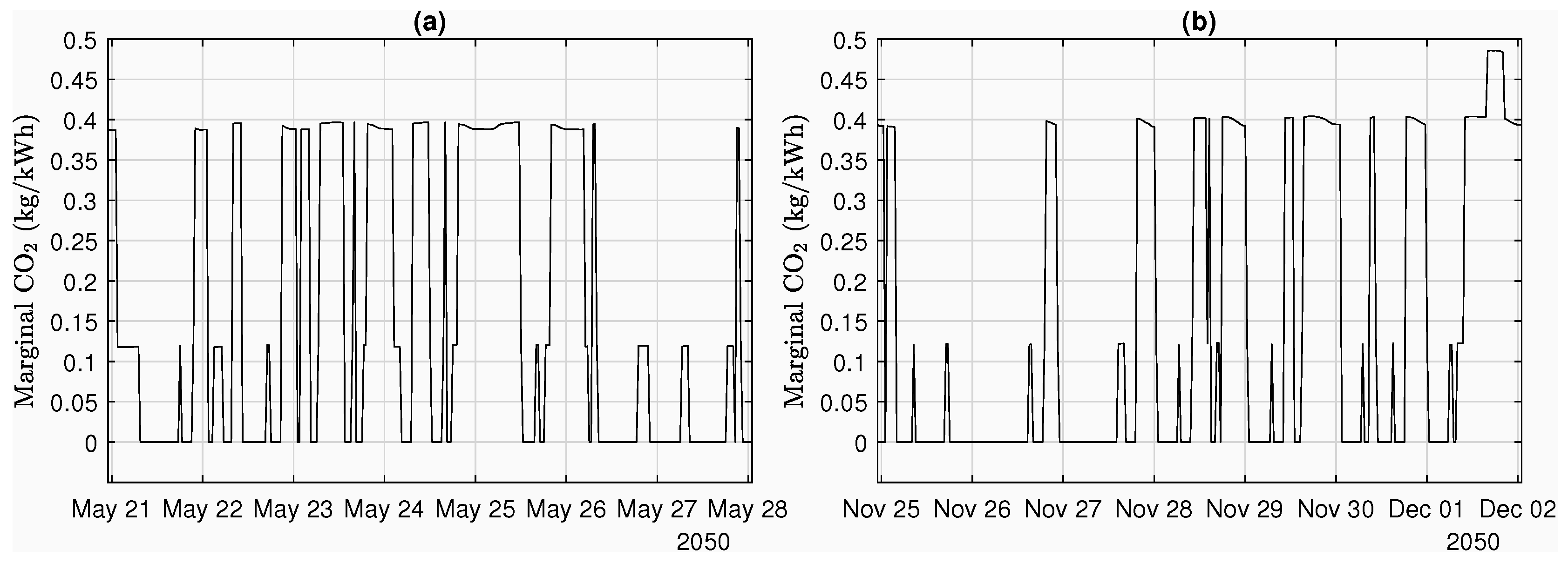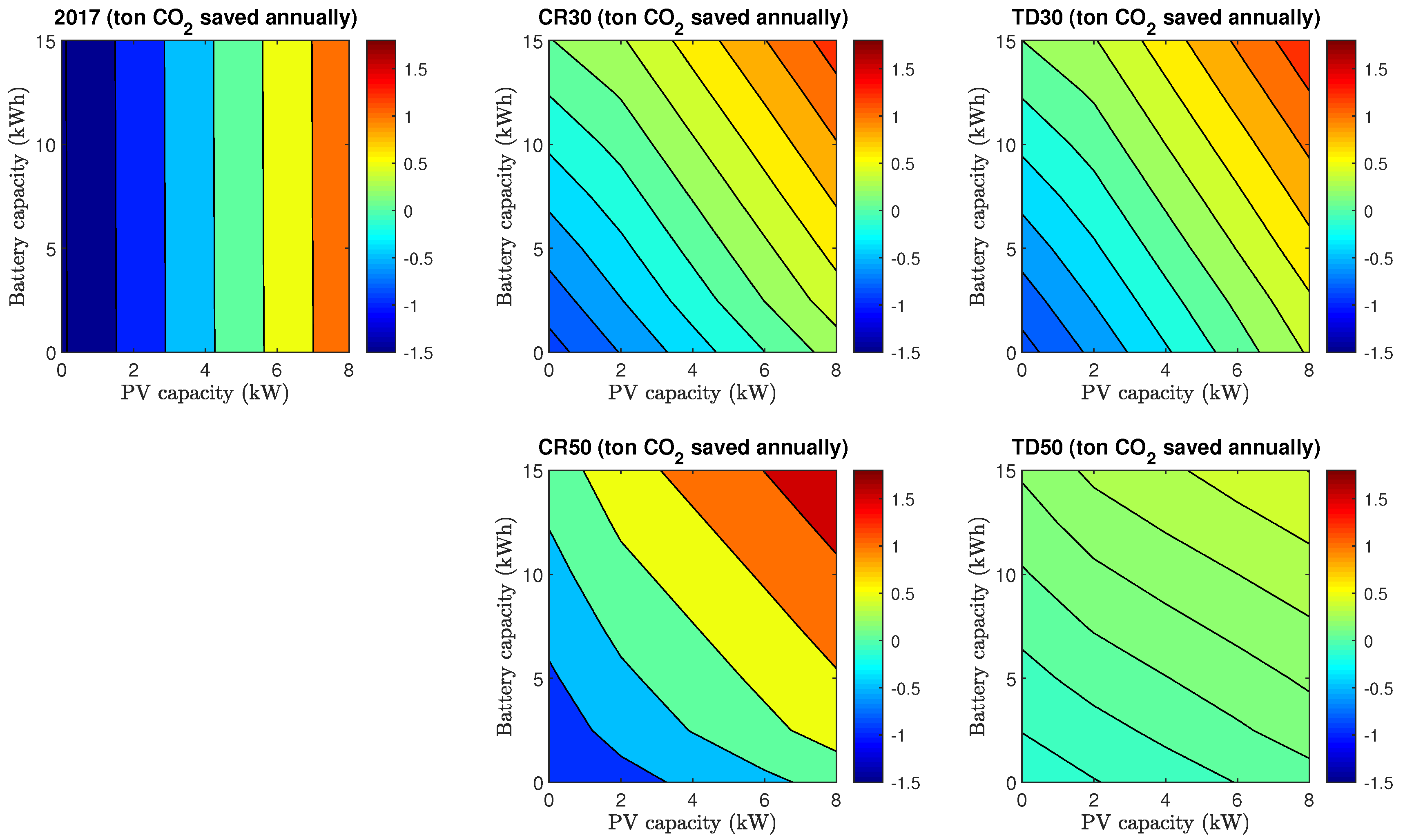1. Introduction
There is growing interest in home battery products such as the Tesla PowerWall [
1], Moixa Maslow [
2], SolarWatt MyReserve [
3], BYD B-Box [
4], and many others. These complement rooftop solar PV arrays by storing excess generated energy that is not consumed onsite immediately, so that it can be used when consumption exceeds onsite generation. Reasons for the uptake of home batteries include the reduction of both electricity bills and dependence on incumbent energy suppliers, the use as backup power, and out of concern for the environment [
5].
While much literature exists on the use of grid-connected domestic PV-battery systems for increasing energy self-sufficiency and reducing electricity bills [
6,
7,
8,
9,
10,
11,
12,
13], literature that examines environmental impacts shows that such systems cannot always be assumed to be ‘green’. Kabakian et al. (2015) [
14] showed that a 1.8 kW PV system with lead-acid batteries in Lebanon had slightly more embodied lifetime greenhouse gas (GHG) emissions than the 1.8 kW PV alone, 92 g of CO
2-equivalent per kWh delivered compared to 89 g/kWh. Jones et al. (2017) [
15] found similarly that PV with battery would save 15% of a non-domestic building’s CO
2 emissions, but PV alone would save 17%. Uddin et al. (2017) [
16] reasoned similarly for lithium-ion batteries in the UK, on the basis that there are environmental impacts from manufacturing them, and additionally energy losses when charging/discharging. The same was found by Fares and Webber (2017) for Texas [
17].
In contrast, Faria et al. (2014) [
18] showed that a second-life electric vehicle battery could reduce global warming, abiotic depletion, acidification and eutrophication factors by 2% when used in a peak-shaving application in France, and 4–5% in a load-shifting application (both without PV). This is because the French grid emissions intensities change throughout the day in such a way that electricity is imported from the grid when emissions are low and exported to the grid when they are high. This ‘emissions arbitrage’ effect was not accounted for in the other papers mentioned, which assumed a constant grid emissions intensity.
A flaw in the work of Faria et al. (2014) [
18] is that they used average rather than marginal emissions intensities. If some grid-generated electricity is displaced by the injection of PV power, or indeed any other intervention, not all the generator types (nuclear, coal, biomass, etc.) would have their output reduced in the same proportion as their total generation. The reduction would occur mostly for the generator type with the highest running cost. This gives rise to the concept of marginal emissions factor (
, as opposed to average emissions factor,
). Studies have shown that using
rather than
can cause errors of up to 25% [
19,
20,
21,
22].
It should also be noted that the battery operating strategies studied by Faria et al. (2014) were not designed to achieve emissions arbitrage. As such, environmental impacts were negative when those operating strategies were applied to Portugal and Poland [
18]. The literature is abundant with algorithms for peak reduction, cost minimization and self-sufficiency maximization [
6,
7,
8,
9,
10,
11,
12,
13]. There is good reason for this: All these objectives are quantifiable and desired by consumers, distribution network operators, or other relevant stakeholders. However, environmental benefit is also desirable, as evidenced by survey data on opinions of renewable energy tariffs [
23] and home energy storage [
5]. Furthermore, it is now thought essential, in a special report by the IPCC [
24], to limit global warming to 1.5 °C above the pre-Industrial average, and so to reduce GHG emissions accordingly.
It is not appropriate to equate energy self-sufficiency with environmental benefit (a link which Sun et al. (2018) [
25] showed to be spurious), nor to regard the home battery as an environmental burden to be traded against a benefit, financial or otherwise [
14,
16,
17]. This study seeks to show that it is possible for home batteries to achieve some environmental benefit even above PV without batteries, by judicious design of an emissions arbitrage algorithm.
To quantify the environmental benefits, it is necessary to produce a time series
which can be projected into the future. A constant average
is insufficient as there is then no scope for emissions arbitrage. Historic
is also insufficient, as the grid technology mix may change drastically over the 25+ years lifetime of a PV array [
26]. Bearing these requirements in mind, existing approaches to finding
are reviewed in
Section 2.
The methodology of this study is described in
Section 3, including the modelled system setup, emissions arbitrage algorithm, sources of input data and how they are processed to calculate the system’s environmental benefit, in the present day and in 2030 and 2050. Results are presented in
Section 4, and discussed in
Section 5, along with further work. The conclusions are in
Section 6.
This study takes a markedly different approach from most of the existing literature on domestic energy storage, which either incorrectly assumes its environmental benefit, or infers a misalignment of the environmental objective with financial and other objectives. A notable exception is the work of McKenna et al. [
27,
28], who do consider time-varying
and the possibility of greater environmental benefits in a future decarbonized grid. The operating algorithm evaluated in their 2013 paper [
27], however, was not designed specifically for emissions arbitrage. Furthermore, a new evaluation is timely, as they had analyzed the UK grid in 2009 (finding the life cycle impacts of a lead-acid battery to be equivalent to increasing an average household’s energy consumption by 21%), and lead-acid has been overtaken by lithium-ion as the dominant home battery technology. Their 2017 presentation [
28], which speculates on the effects of decarbonizing the grid on individual PV-battery systems, is still in need of supporting evidence. This study aims to provide such evidence.
It is shown in this study that by actively designing a new algorithm, environmental benefit can be achieved, as long as the time-varying nature of is accounted for. It is by no means easy, and may still require changes in government policy to align the objectives. Even so, the rise of energy storage and demand response, in smart grids or virtual power plants, is revolutionizing renewable power by making it dispatchable: In other words, not constrained by uncontrollable forces such as weather. It is therefore vital to consider time-varying in all such systems where algorithms are designed to control their dispatch, beyond just domestic PV-battery systems.
2. Literature Review of MEF
The problem is to calculate the marginal emissions factor , or better yet, the marginal generator response MGR(t), over time and in possible future scenarios with generation technology mixes different to today. The existing literature is reviewed against this goal. The main difficulty is that the problem deals with a hypothetical situation: For a hypothetical increase or decrease in total demand, what would the power generators do differently from otherwise? As the hypothetical situation never truly exists, the solution (or its validation) lies in finding appropriate proxies.
Bettle et al. (2006) [
19] derived a fixed merit order by analyzing historical load duration curves of electricity generation plants in the UK. That is, the plants that output closer to their maximum for more of the time were identified as baseload and are thus higher in the merit order, whereas plants that output their maximum for less of the time were identified as load-following, or for even less of the time, as peaker plants, and occur lower in the merit order. The demand in each moment is then met by the plants in merit order, and the lowest-merit plant needed to fulfil the demand is the marginal generator. In reality, the merit order is not fixed but depends dynamically on running costs, electricity price, physical constraints, etc. Only a single average figure across the year for marginal CO
2 intensity was given with confidence, so this method could not be used to derive time-varying
.
Hawkes (2010) [
20] performed a linear regression of the hour-to-hour change in total CO
2 emissions (
) against the hour-to-hour change in total demand (
) of the UK grid, to derive
as the gradient
/
(kg/kWh). In essence, the proxy used for hypothetical changes in demand are real changes in demand
at different times across the year. McKenna et al. (2017) [
21] applied this method to the Irish grid by binning the data by total demand
D and performing linear regressions separately within each bin. This allowed them to produce time series of marginal CO
2 intensity. Siler-Evans et al. (2012) [
22] did similarly for various grids in the USA, producing time series of marginal SO
2 and NO
x as well as CO
2 intensity. However, being based on historical data, there was no clear way to extend this method to possible future generation mix scenarios.
Olkkonen and Syri (2016) [
29] used the energy dispatch model EnergyPLAN to simulate operation of the Nordic grid. They ran the model once for a real year, and again for a hypothetical year with demand constantly greater than in the real year to a total of 1 TWh, finding the
from the difference in resultant CO
2 emissions between them. While EnergyPLAN has been extensively peer-reviewed, the
time series produced was not validated against other methods.
The work by Lane Clark & Peacock and EnAppSys (2014) [
30] on the other hand does compare four methods of producing
. These are: Merit order by running cost (out of all the final physical notifications given before gate closure), identifying the load-following plant (the one that increases or decreases output most closely in line with demand at the time-step in question and up to three half-hour periods before and after), highest bid or offer in the Balancing Mechanism (BM, a fairer reflection of merit order at delivery time rather than at gate closure an hour before), and running the Department of Energy and Climate Change Demand Dispatch Model (DECC DDM—similar in principle to the method of Olkkonen and Syri (2016) [
29]). There were discrepancies between all the methods when applied to UK historic data, owing in part to plants running ‘out of merit’. For example, running overnight despite high running costs because the costs of startup/shutdown are even greater. While LCP and EnAppSys judged the BM method the best, only the DDM method can be used to project future marginal generator responses, as the others all rely on historic data [
30].
3. Method
The modelling of the domestic PV-battery system and emissions arbitrage algorithm is described here. It requires as input the marginal emissions factor time series
, which is calculated for the UK in 2017 using an adaptation of Hawkes’ method [
20], and also for 2030 and 2050 using National Grid’s Future Energy Scenarios [
26]. This is then used to calculate the potential CO
2 arbitrage impact of the domestic PV-battery system. All Matlab code used in this study is available as the
Supplementary folder ‘matlab_code’. It was developed in Matlab R2018a.
In the following work only short-run impacts of avoided emissions were considered, as opposed to long-run impacts such as avoided construction of new peaker plants due to an intervention reducing peak electricity consumption enough to render such construction unnecessary. The latter were treated exogenously.
3.1. System Setup and Inputs
The system studied here is a single household PV array and home battery (
Figure 1). For input to the simulation, electrical consumption data were collected at 5-min resolution from 1 February 2012 to 31 January 2013 by E.ON UK plc., for a house in the Midlands, UK, with annual consumption 3845 kWh, close to the present-day UK average of 3800 kWh. PV generation data were collected from 2 December 2015 to 30 November 2016 from a 3.6 kW array on a 45°-inclined southeast-facing roof in Berkshire, UK. It was averaged from 2-s to 5-min resolution, to match the load data. More detailed system parameters are given in
Appendix A.
The base case PV capacity is set to 4 kW, which covers the annual consumption of 3845 kWh. Home batteries are available in a range of sizes, from the 2.2 kWh Moixa Maslow [
2] to the 14 kWh Tesla PowerWall 2 [
1], and so an intermediate value of 7.5 kWh was chosen for the base case. The effects of varying PV and battery capacities are shown in
Section 4.2.
Generated power (MW) and total demand (MW) in the UK at 5-minute resolution for the year 2017 were downloaded from the GridWatch website [
31]. This data source was chosen as being reliable, being synthesized from Elexon BM reports [
32], but much more easily accessible (any desired time period from 2011 onwards can be downloaded as a CSV spreadsheet). The power generation data are aggregated by type: Coal, CCGT (combined cycle gas turbines), biomass, hydroelectric, wind, and various interconnectors. This was deemed a suitable level of granularity for application of Hawkes’ method (
Section 3.2).
To reduce the impact of missing data points, the GridWatch data were averaged from 5-min to half-hourly resolution. This left 97.5 h of data still missing out of a total 8760 h in 2017. Missing data were replaced by interpolation.
3.2. Adapted Hawkes’ Method for MEF(t)
Although Hawkes’ method [
20] cannot be used to make future projections, some insight can be gained by applying it to the generation data of 2017. Siler–Evans’ adaptation to Hawkes’ method was followed in this work [
22]:
Firstly, rather than linearly regressing the change in emissions
from one time step to the next against the change in demand
, the change in power from each generator type was taken as the dependent variable. That is,
was regressed against
, where
P is generated power (MW) from
= coal, CCGT, biomass, nuclear, hydroelectric, French interconnector, Dutch interconnector (these being the most significant generator types, together supplying over 97% of the total demand [
31]). Thus it is possible to apply conversion factors to obtain not just CO
2, but also SO
2, NO
x, and other marginal emissions impacts.
Secondly, in addition to binning the data by total demand , they were further binned by month. That is, instead of performing the linear regression on all the data in 2017, separate values of the gradient regressing on were obtained for each month and each demand bin ( GW, 20 GW GW, …, GW). This way it was possible to capture seasonal effects, notably the decreased usage of coal in summer compared to winter. Note that to improve linear fit quality, run-of-river and pumped hydroelectric were summed to give the single category ‘hydroelectric’. Only CCGT showed sufficient fit quality to perform the linear regression on single months; for the other generator types, the temporal bins are two-month periods.
From the gradients
/
, are derived time series of marginal generator response
(MW/MW). The time series of marginal emissions intensity is then given by:
where
is the intensity of emissions (for example CO
2 emissions, in kg/kWh) from generator type
j.
Although
can be substituted with the intensity of any type of emissions (SO
2, NO
x, even U235-equivalent for ionizing radiation), the principle is demonstrated here only with CO
2. The values used are those obtained by Staffell (2017) [
33], listed in
Table 1, and include the effects of typical load factors. They are for short-run emissions only, excluding embodied emissions of plant construction—those need to be added separately in a life cycle analysis, for example, of a PV-battery system. Although the energy absorbed by pumped hydroelectric is partly fossil-fuelled, this is included in the demand
and so the short-run CO
2 intensity of hydroelectric generated power is taken to be zero.
3.3. Emissions Arbitrage Algorithm
The emissions arbitrage operating algorithm designed for this study takes as input the
time series described in
Section 3.2. Only generator dispatch up to 5 min previously is knowable, from which
is easily calculated from the previous month’s dispatch data using the regression method of
Section 3.2. The
Supplementary Movie File ‘algorithm_movie.mp4’ explains the algorithm (still frames in
Appendix A). The battery is set to discharge at rate
until it is empty while the instantaneous
is above a given limit
, and to charge at
until it is full while instantaneous
is below limit
. When discharging, any excess power from both PV and battery above the load is exported (in
Figure 2: 00:00–01:00, 05:40–10:55, 19:45–22:55), or if they are not enough, any remainder is imported to serve the load (01:00–05:40, 22:55–00:00). When charging, any excess PV power not used by the battery or load is exported (10:55–16:50 except 12:10–12:40 and 13:40–14:30), or if insufficient, power is imported from the grid to charge the battery (12:10–12:40, 13:40–14:30, 16:50–19:45). The limits
and
are continuously updated, set respectively at 0.02 kg/kWh below and above the mean of the previous 30 days’
. In other words, the deadband is 0.04 kg/kWh.
The charge/discharge rate limit
is varied from 0.1–0.5 C (0.75–3.75 kW for a 7.5 kWh battery), and the effects shown in
Section 4.2.
3.4. Future Grid
To derive
for future scenarios, the 2018 edition of Future Energy Scenarios (FES) [
26] produced by National Grid (the UK’s transmission system operator) was used. Four scenarios are presented, these having different characteristics in terms of degree of centralization and speed of decarbonization. This study limits itself to analyzing the two scenarios with fastest decarbonization, as only these allow the UK to meet its Paris Agreement target [
34]: the more decentralized one is termed ‘Community Renewables’ (CR) and the more centralized one ‘Two Degrees’ (TD). Their demand characteristics and generator total capacities are given in
Table 2, for 2030 and 2050, and also 2017 [
35]. Note that the present-day UK grid consists of almost constant nuclear power as baseload, augmented by coal in winter. Despite significant wind and PV capacities, most UK electricity is still generated by CCGT, which performs most of the load-following, aided by a small amount of hydroelectric power. There is a move to replace coal with biomass, whose capacity remains small. Power can flow in the interconnectors to France, the Netherlands and Ireland, in either direction as determined by prices in each region [
31].
A rule-based dispatch was used within these parameters to produce time series of power output by each generator type. The simplification of a fixed merit order was used for the future scenarios, going from low-carbon to higher-carbon generator types until the demand in that period
is satisfied. This is justified by an anticipated increase in the carbon price. Staffell (2017) [
33] has shown the UK’s carbon price floor to have already had an effect in terms of CCGT displacing coal in the merit order compared to as recently as 2012.
As total demand time series for each of the future scenarios was presently unavailable upon request, the demand for 2017,
, is scaled and shifted such that the annual total and peak demand match those given in
Table 2 for each scenario:
for each scenario
= CR30, TD30, CR50, TD50. Values for the constants
and
are given in
Appendix B.
Wind and PV time series are taken from the 2017 Gridwatch data and scaled in proportion to their capacities in the future scenarios. In FES 2018 [
26] it is assumed that power flows across interconnectors are only limited by total capacity, when in reality they depend on prices in the two interconnected regions. This simplification is kept in this study, with the further simplification that when exporting, all interconnectors have associated CO
2 intensity equal to that of France, and when importing, their CO
2 intensity is equivalent to that of the Netherlands. The reasoning is that some correlations in demand and renewable energy supply exist throughout Europe, so any export from the UK in future is likely to displace low-carbon generators (high in the merit order), and vice versa for imports to the UK. The interconnectors to France and the Netherlands transmit the greatest flows today compared to those to Ireland, and they have respectively low and high grid CO
2 intensity (
Table 1). Although interconnections to Spain, Norway, Denmark, Germany, and Belgium are also anticipated in FES 2018 [
26], the capacities of each are not revealed due to commercial sensitivity. Better accuracy than with the approximations used here is beyond the scope of this study.
Only nominal power (GW) of energy storage and vehicle-to-grid (V2G) were given in FES 2018 [
26], but not their energy storage capacities (GWh). As such, there was not enough information to incorporate storage directly in the generator dispatch model in this study. However, storage is considered as an aggregation of home batteries as described in
Section 3.5.
3.5. Calculation for Domestic PV-Battery System
This study calculates the annual CO
2 savings from the PV-battery system in 2017 and for CR and TD scenarios in 2030 and 2050. Two methods are employed to calculate annual CO
2 savings. Firstly, the generator dispatch model (
Section 3.4) is run with no storage, and again with demand
greater by 1 MW constantly. The difference between them gives the marginal generator responses
from which
is calculated, similarly to the method of Olkkonen and Syri (2016) [
29] and DECC DDM [
30]. This
is fed into the PV-battery simulation along with a portion of
and PV generation in each scenario, as detailed in
Table 3 (the loads, PV and batteries of the whole country are approximated as lumped together). The simulation output is used to adjust
to account for the presence of all the PV-battery systems. The generator dispatch model is then run again with the storage-adjusted demand as input. The difference in CO
2 emissions between the runs with and without storage is divided by the total PV capacity of participating PV-battery systems, and multiplied by 4 kW, to give the average contribution to CO
2 savings of a 4 kW PV system with batteries.
The second method takes the difference in emissions between the storage-adjusted demand described above, and that adjusted demand plus a further 1 MW constantly, again from running the generator dispatch model for each of those cases. The resultant series is fed into the PV-battery simulation for a single PV-battery system with household electrical consumption as measured by E.ON UK plc. That is, a real single system is simulated as opposed to an aggregated system of all participating systems in the country. The grid export series thus obtained (import is counted as negative export) is multiplied element-wise by the series interpolated to 5-min resolution. This gives the CO2 savings of the single system in question, when operated simultaneously to many other such systems nationally. In other words, the first method gives the contribution of an average system on the national level while the second gives the marginal impact of the last, or nth, system installed.
5. Discussion
Using the adapted Hawkes’ method to derive for 2017, different results were found when using the full time series as opposed to the repeated average day’s . This shows the importance of using the full time series, as the grid CO2 variation is not adequately represented by an average day, nor is the average day representative of any single real day within the year.
It should be noted in
Figure 6 that the CO
2 benefit of PV only is less in the 2030 scenarios than in 2017, and less again in 2050. That is, rooftop PV becomes less impactful as the grid decarbonizes. In contrast, the
nth-system benefit of a home battery operating the emissions arbitrage algorithm is much greater in all the future scenarios than in 2017. This is the benefit of the battery above the same system with PV only. This challenges the previous literature [
14,
15,
16,
17,
25,
27] which finds home batteries to reduce the benefit of rooftop PV, showing the utmost importance of operating strategy design. If such emissions savings could be realized across the battery lifetime, the CO
2 debt of manufacturing it could be repaid and more. This is impossible, however, if the UK’s grid technology mix continues as it is today, with the marginal generator response being almost wholly CCGT, as there is then insufficient variation in
for the algorithm to arbitrage effectively.
As system interactions were not accounted for, the results for the average system are not as reliable as those for the
nth system. This would need to be addressed in future work. It could then be determined more conclusively whether a higher C-rate limit truly does yield greater CO
2 savings in the
nth system but less when considering the average contribution of many PV-battery systems compared to the national system without any PV-battery. Doing so would also bridge the gap between short-run emissions impacts studied here, and long-run impacts on the national generating infrastructure [
28]. If the environmental benefit still does not pay back the burdens of manufacturing and installing home batteries, other benefits must be seriously weighed against lifetime environmental impacts. These were not addressed in this study, but include avoidance of distribution losses in cases where these may be high for PV export to the grid [
25], and reduction of voltage violations on the distribution network [
40].
Although the battery benefit is greater in the lower-carbon future scenarios, it becomes small again in TD50, a scenario characterised by over twice as much nuclear generating capacity (18.6 GW) than the others, and 12.1 GW of CCS. does not vary enough when there is so much low-carbon power on the grid. It must be hoped that improvements in battery lifetime and efficiency keep pace with progress in grid decarbonization. The emissions arbitrage algorithm itself may also be improved, perhaps using dynamic programming with forecasting of generation and demand, to optimally schedule the battery dispatch, rather than blindly charging/discharging until full/empty.
This study does not constitute a life cycle analysis. For this, it would be necessary to define the system boundaries and functional unit, for example, kWh delivered [
41]. The environmental impacts across the whole system lifetime must be calculated, including manufacture, operation and disposal/recycling of all components, and then divided by the total energy supplied to the household loads and exported to the grid, to find the impacts per kWh. This must be done for other impact categories in addition to global warming. Even though a CO
2 benefit appears possible by operating the battery with the emissions arbitrage algorithm, the same may or may not be true for SO
2, NO
x or human toxicity, for example. Further, it will be necessary to account for degradation of the battery and PV over the system lifetime.
The validity of the future scenarios
are only as good as the dispatch modelling used to obtain them. A highly simplified fixed merit order was assumed in this study: The advantage of transparency and easy reproducibility comes at the cost of no account being taken of price dynamics, generator ramping or part-loading, nor transmission constraints. Since National Grid ran the BID3 dispatch model for their FES 2018 analysis [
26], which takes these factors into account, an obvious next step would be to apply the adapted Hawkes’ method to their BID3 results, to see if
differs greatly from that obtained here. However, it has not been possible to obtain the BID3 results required.
Finally, it would be valuable to conduct financial analyses of the PV-battery system running the emissions arbitrage algorithm. Such information, together with visualizations like those in
Figure 9, can help a customer choose the PV-battery capacities combination to maximize CO
2 savings within the constraints of their initial investment. This would depend on the customer’s household load profile, and so it would be valuable to analyze the effects of above- and below-average consumption. A lower net present value and/or internal rate of return, or longer payback period compared to a PV-only system may be tolerated by some particularly environmentally conscious consumers. However, a change in policy may be necessary to align the environmental and financial incentives, for example, linking a subsidy to kg CO
2 (or other emissions) saved. With smart meters and home batteries themselves commonly recording data at 15-min resolution or better, the only issues would be a need to standardize the calculation of
and the verification of each household’s emissions savings in a way that respects data privacy. Another possibility is for energy suppliers to offer a time-of-use tariff dependent on
. Considering Wadebridge Renewable Energy Network’s Sunshine tariff trial (
https://wren.uk.com/sunshine) and Green Energy UK’s Tide tariff (
https://www.greenenergyuk.com/tide), this is already an idea with commercial applications.
6. Conclusions
In this study, a novel PV-battery operating algorithm was designed specifically to perform emissions arbitrage: Charging when grid emissions intensity is low and discharging when it is high. To accurately quantify its environmental performance, it was necessary to use:
The marginal rather than average emissions intensity,
A full year time series rather than a constant value, or an average day,
A projection of the future power grid rather than only the present-day.
These goals were achieved by applying Siler–Evans’ adaptation [
22] to Hawkes’ method [
20] to UK 2017 data from Gridwatch [
31] to find
for the present day. For the future, National Grid’s FES 2018 [
35] was used to parametrize a fixed merit order generator dispatch model.
It is shown to be possible for a home battery to fully repay its CO
2 debt of manufacture by operating the emissions arbitrage algorithm. In contrast to previous literature which finds an environmental benefit associated with domestic PV-battery, but less than that of PV alone [
14,
15,
16,
17,
27], the benefit found here is for the system with battery relative to without. However, this benefit is contingent on
varying sufficiently, underlining the importance of decarbonizing the whole electricity grid. Otherwise this variance will not be achieved if CCGT remains on the margin nearly all the time.
Further work was identified:
Use an improved dispatch model for future scenarios,
Correctly account for interactions between PV-battery systems,
Improve the algorithm,
Conduct a life cycle analysis, including environmental impacts other than only GHG emissions,
Conduct a financial analysis, with a range of household load profiles, to identify if policy changes are required to align financial and environmental objectives.
In closing, a rooftop PV with home batteries is one example of a dispatchable decarbonizing intervention; other researchers are encouraged to apply the methods presented here to design emissions arbitrage algorithms and evaluate their performance for other systems: Commercial- or utility-scale PV or wind farms, or other renewable power sources, in combination with batteries, compressed air, pumped hydroelectric, or other forms of energy storage, or demand response. To aid this endeavour, all Matlab code and a spreadsheet of numerical results are available as
Supplementary Files.



